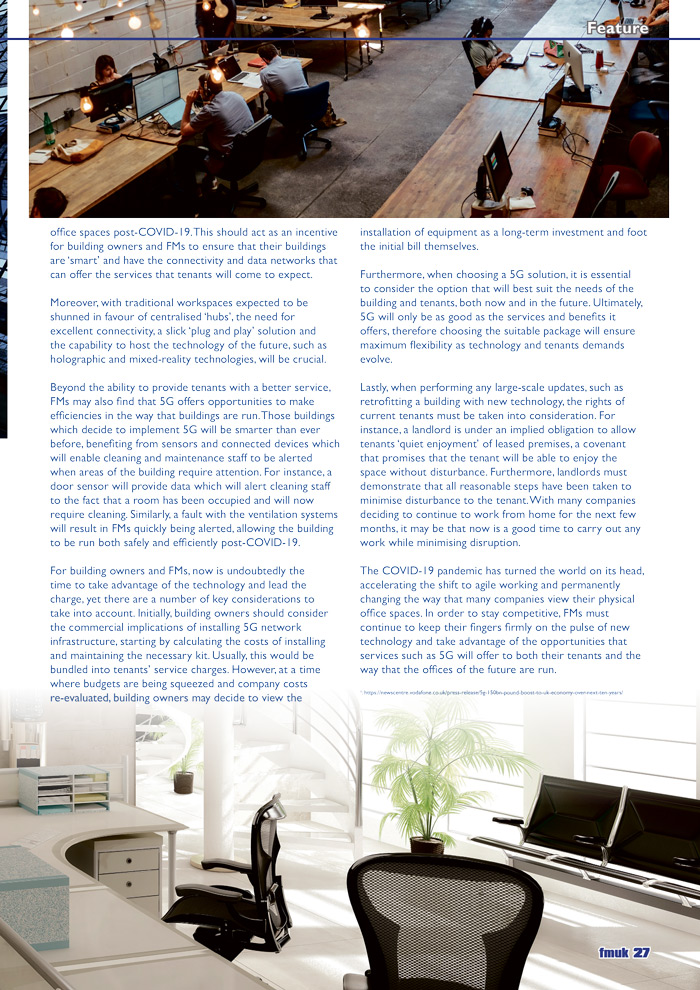5G Post-COVID-19: Developing The Office Of The Future
 James Fownes, partner and real estate disputes specialist at law firm, Shakespeare Martineau, explores the need to provide attractive workspaces for tenants going forward and 5G’s place in creating the office of the future.
James Fownes, partner and real estate disputes specialist at law firm, Shakespeare Martineau, explores the need to provide attractive workspaces for tenants going forward and 5G’s place in creating the office of the future.
The COVID-19 pandemic forced companies to fast-track their agile working plans, in a matter of months homeworking has become a way of life for almost 50 percent of British workers. However, as the country begins to move out of lockdown and into the ‘new abnormal’, attention is turning to physical workplaces and how they can be made as safe, attractive, and productive as possible.
While it seems unlikely that companies will ever completely forgo the physical office, the way that they are used is expected to change dramatically. Therefore, in a market where companies are currently evaluating the use of their office spaces, facilities managers (FMs) must be aware of the cultural and technological changes on the horizon and ensure that their buildings stand out from the competition.
With a new study reporting that 5G could provide a £150bn boost to the UK economy over the next 10 years, it seems that this next step in mobile technology will play an important role in changing the way the public uses vital services after the COVID-19 outbreak. In a time where new technology is merging with a fresh approach to working life, 5G has the potential not only to increase connectivity but also to improve security, efficiency and importantly, wellbeing.
From identifying the quietest times to arrive at the office to the availability of desk spaces and onsite parking, 5G will offer tenants unprecedented visibility over the status of their office spaces post-COVID-19. This should act as an incentive for building owners and FMs to ensure that their buildings are ‘smart’ and have the connectivity and data networks that can offer the services that tenants will come to expect.
Moreover, with traditional workspaces expected to be shunned in favour of centralised ‘hubs’, the need for excellent connectivity, a slick ‘plug and play’ solution and the capability to host the technology of the future, such as holographic and mixed-reality technologies, will be crucial.
Beyond the ability to provide tenants with a better service, FMs may also find that 5G offers opportunities to make efficiencies in the way that buildings are run. Those buildings which decide to implement 5G will be smarter than ever before, benefiting from sensors and connected devices which will enable cleaning and maintenance staff to be alerted when areas of the building require attention. For instance, a door sensor will provide data which will alert cleaning staff to the fact that a room has been occupied and will now require cleaning. Similarly, a fault with the ventilation systems will result in FMs quickly being alerted, allowing the building to be run both safely and efficiently post-COVID-19.
For building owners and FMs, now is undoubtedly the time to take advantage of the technology and lead the charge, yet there are a number of key considerations to take into account. Initially, building owners should consider the commercial implications of installing 5G network infrastructure, starting by calculating the costs of installing and maintaining the necessary kit. Usually, this would be bundled into tenants’ service charges. However, at a time where budgets are being squeezed and company costs re-evaluated, building owners may decide to view the installation of equipment as a long-term investment and foot the initial bill themselves.
Furthermore, when choosing a 5G solution, it is essential to consider the option that will best suit the needs of the building and tenants, both now and in the future. Ultimately, 5G will only be as good as the services and benefits it offers, therefore choosing the suitable package will ensure maximum flexibility as technology and tenants demands evolve.
Lastly, when performing any large-scale updates, such as retrofitting a building with new technology, the rights of current tenants must be taken into consideration. For instance, a landlord is under an implied obligation to allow tenants ‘quiet enjoyment’ of leased premises, a covenant that promises that the tenant will be able to enjoy the space without disturbance. Furthermore, landlords must demonstrate that all reasonable steps have been taken to minimise disturbance to the tenant. With many companies deciding to continue to work from home for the next few months, it may be that now is a good time to carry out any work while minimising disruption.
The COVID-19 pandemic has turned the world on its head, accelerating the shift to agile working and permanently changing the way that many companies view their physical office spaces. In order to stay competitive, FMs must continue to keep their fingers firmly on the pulse of new technology and take advantage of the opportunities that services such as 5G will offer to both their tenants and the way that the offices of the future are run.























































